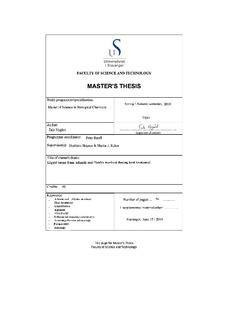| dc.contributor.advisor | Skipnes, Dagbjørn | |
| dc.contributor.advisor | Blikra, Marthe | |
| dc.contributor.author | Nygård, Tale | |
| dc.date.accessioned | 2019-10-22T13:37:40Z | |
| dc.date.available | 2019-10-22T13:37:40Z | |
| dc.date.issued | 2019-06-15 | |
| dc.identifier.uri | http://hdl.handle.net/11250/2623778 | |
| dc.description | Master's thesis in Biological chemistry | nb_NO |
| dc.description.abstract | This thesis concerns a project in cooperation with Nofima, where we consider the mechanisms behind water loss during cooking of Atlantic cod (Gadus morhua). The thesis is a closing part of a master program in Biological Chemistry at the University of Stavanger, spring semester of 2019.
During cooking of fish muscle, pressure gradients are formed, and in their presence excess liquid is moved to the surface of the fish, and this expelled liquid is known as cooking loss. In the present study, the cook loss from cod fish muscle was studied as a function of temperature. The comparative study of the cook losses as presented in this thesis yields insight about the content of the liquid which is released and its properties, which in turn can say something about the ability of the cod fish muscle to hold liquid after various heating treatments.
3 x 2 cm samples from cod loins were vacuum packed together with a glass tube, heat treated in a water bath, and the cook loss was continuously collected in the glass tube. The amount of cook loss collected increased substantially when heating cod muscle at 40 C and at 70-90 C. It was observed by scanning electron microscopy that more fibrous proteins were expelled at higher temperatures. Sodium dodecyl sulphate–polyacrylamide gel electrophoresis analysis revealed that these proteins were the myosin heavy chain. Pressure induced water flow experiments were used to obtain the permeability of cod muscle. The permeability was slightly lower at 60◦C and 90◦C, compared to the permeability at 40 ◦C. The decrease in permeability do not correlate well with the substantial increase in water loss at these temperatures.
Thermophysical properties were measured for mass transfer modelling purposes. It was found that the density of the cook loss was larger and that the specific heat capacity was lower, when compared to pure water. The viscosity of the cook losses was found to be complex, but the values were always larger than that of pure water.
The properties that were acquired in this thesis can be further used to improve mathematical models of cooking of cod, which in turn can be used to optimise cooking treatments and prepare healthy fish meals of higher and more stable quality. | nb_NO |
| dc.language.iso | eng | nb_NO |
| dc.publisher | University of Stavanger, Norway | nb_NO |
| dc.relation.ispartofseries | Masteroppgave/UIS-TN-IKBM/2019; | |
| dc.subject | biological chemistry | nb_NO |
| dc.subject | biochemistry | nb_NO |
| dc.subject | biokjemi | nb_NO |
| dc.subject | biologisk kjemi | nb_NO |
| dc.subject | Atlantic cod | nb_NO |
| dc.title | Liquid losses from Atlantic cod (Gadhus morhua) during heat treatment | nb_NO |
| dc.type | Master thesis | nb_NO |
| dc.subject.nsi | VDP::Mathematics and natural science: 400::Basic biosciences: 470::Biochemistry: 476 | nb_NO |
